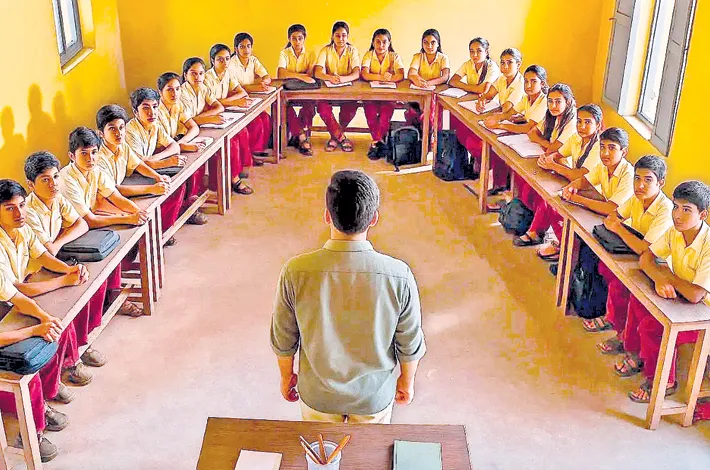Necks on the line: U-shaped classrooms, not a great idea!
14-07-2025 12:00:00 AM

■ How to make U-Shape work safely
■ Rather than dismissing U-shaped seating outright, schools can take steps to mitigate the harm:
■ Rotate student seating weekly, distributing physical strain
■ Use digital boards, projectors at multiple angles to reduce extreme head turns
■ Angle desks inward and use chairs with lumbar support
■ Install additional whiteboards, ensuring no one has to turn beyond 30–45 degrees
■ Shorten lecture sessions, interspersing them with activities or movement
■ Add stretch breaks every 30–40 minutes
Hyderabad: In an age where classroom innovation is celebrated, the recent adoption of U-shaped seating popularized by the Malayalam film Sthanarthi Sreekuttan has sparked a national buzz. Kerala schools are at the forefront of this transformation, reimagining classrooms as semi-circular discussion arenas. Headlines hail it as revolutionary: ‘No more backbenchers!’
Indeed, the model offers inclusivity, visibility, and a democratic learning environment where no child is left behind. But as educationists cheer, doctors raise a brow. Beneath the utopian surface lies a less glamorous truth: students turning their necks unnaturally for hours. Are we exchanging one problem for another?
The core idea behind U-shaped seating is visibility every student sees and is seen. The teacher stands center stage, orchestrating a space where eye contact is shared, and attention is equalized. However, most classrooms still have a single board placed in the traditional front. As a result, students seated at the extreme curves of the U must turn their heads sideways often for prolonged durations to view the board or teacher.
This seemingly minor neck turn, repeated every day over weeks and months, can lead to lasting harm.Dr. Sushant Reddy, an orthopedic surgeon at Apollo Hospitals, Hyderabad, cautions ‘The cervical spine is not built for sustained lateral turns. Among children, who are still developing, this posture can lead to chronic pain, poor posture, and in extreme cases, early disc damage.’
Pediatric physiotherapist Dr. Anita Joseph from Kochi adds ‘Even 20 minutes of sideways attention during a blackboard session can cause tightness and early onset of what we now see as ‘student neck syndrome’—a growing concern.’
Between the ages of 6 and 16, the spine is still forming. This makes it especially vulnerable to long-term poor posture, including conditions like kyphosis (hunchback) and cervical lordosis (excessive neck curvature). With repetitive strain on one side of the body, children may develop asymmetries that persist into adulthood.
Some of the documented physical consequences of prolonged U-shaped seating include lateral neck flexion, stressing neck muscles, twisted writing posture, affecting spine alignment, eye strain from angled board views, reduced wrist and arm support, especially near desk bends and static sitting, which affects circulation and increases fatigue
Psychological Ironies
Though meant to improve engagement, 360-degree visibility can heighten anxiety in introverted or neuro divergent students. Constant eye contact or being seen from all angles can create stress, reduce concentration, and invite peer distractions. Child psychologist Dr. Urmila Reddy observes ‘Classrooms must ensure cognitive safety. For many students, excessive exposure leads to disengagement, not inclusion.’
Teachers under pressure
U-shaped layouts also impact teachers. To maintain visibility and engagement, they must constantly move, turn, and project their voice across an arc leading to voice strain and reduced classroom control. Training in movement-based instruction becomes essential.
The cost of looks vs health
For government schools already grappling with broken furniture and overcrowding, retrofitting U-shaped seating may feel aspirational but impractical. Without proper infrastructure—such as larger rooms, ergonomic desks, and tech integration—the setup risks harming children more than helping them. Innovation must be guided by evidence, not cinema or trends. U-shaped seating can be a useful tool, but only when used sparingly and thoughtfully.
Education departments should conduct pilot studies with ergonomic assessments, gather feedback from students, teachers, and health professionals.Let us not rush to fix the problem of backbenchers by creating a new generation of neck-benders. Every seating model must serve the lesson’s goal, not dictate it. In classrooms of the future, may no child be out of sight, but also, may no child suffer out of posture.
- Rekha, Educationist








